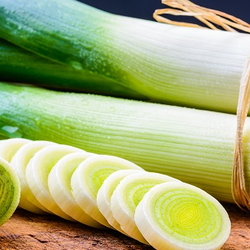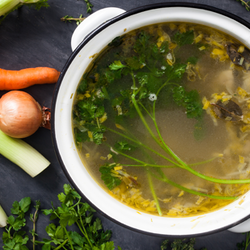(Editor's Note: This article was originally published on September 27, 2009. Your comments are welcome, but please be aware that authors of previously published articles may not be able to respond to your questions.)
Fall leeks are generally defined as those types that will "hold" well through the winter in the ground, since they need about 90 days or more to mature. Holding requires that they be both cold-hardy and disease-resistant, especially where winters tend to be soggy. Being a cool season crop, however, leeks will always taste better when grown in chilly temperatures as opposed to the warm or uneven temperatures experienced by spring plantings.
And, as far as other desirable leek qualities are concerned, the longer the white shaft or "shank" portion, the better, as most recipes that include leeks specify using the white part only. As a result, some hybrids will produce a longer white shank. Hilling soil around the leek as it grows will also serve to blanch the shank, resulting in a longer white portion.
Some of the best leeks for winter harvest or over-wintering are listed as follows:
'American Flag': Mild, sweet, onion-like flavor. Very hardy, good for over-wintering in milder climates. The 7 to 9 inch stems blanch snowy white and are topped with blue-green leaves resemble giant scallions. 130 days to maturity
'Arena': Very upright plant with hardy blue-green leaves. Over-wintering type. Resistant to fall frost and leaf spot. 110 days to maturity.
'Bandit': Very winter hardy. Beautiful dark blue-green erect leaves and good uniformity. 120 days to maturity.
'Blue Solaize': Beautiful French heirloom, blue-colored leaves that turn violet after a cold spell. Very large, 15 to 20 inch stalks, sweet medium-long shaft, extremely hardy. Also known as 'Blue Solaize' and 'Bleu de Solaize'. 100 to 120 days to maturity
'Giant Musselburgh': Heirloom introduced in 1834, near Edinburgh, Scotland. Large, very thick stems, tasty mild flavor. Huge size, very winter hardy. 100 days to maturity.
'Laura': Medium length, extremely hardy. Upright leaves are dark blue-green. 180 days to maturity
'Leefall': Upright blue-green leaves, 8-inch, white interior. Use for fall harvest or over-wintering. Resistant to some foliage diseases. 108 days to maturity.
'Tadorna': Vigorous grower with a medium-length white shaft and contrasting, upright, very dark blue-green foliage. Holds in the field for fall into winter harvest, and overwinters where winter cold is moderate. Resistant to leaf diseases. 100 days to maturity
The Lyon: English Heirloom. Very long, thick, tender, pure-white stems. Widely adapted and very cold hardy. Also known as 'Prizetaker' and 'The Lyon Prizetaker'. 120 days to maturity
'Upton': Vigorous, cold-hardy upright plants with 10-13" long, medium-thick shafts with beautiful blue-green foliage. 90 days to maturity.
Seeds for most of the types listed above are widely available.
Here in North Texas, I've grown and over-wintered ‘American Flag' and ‘Giant Musselburgh', both with great success. We can get surprisingly cold weather here and lots of rain, but each of these varieties did well.
A perfect soil mixture for leeks is half sand, half compost. Since excessive moisture can be a problem during the winter months, sand allows for better drainage. It also makes for a nice loose soil that is conducive to good root crop growth and easy harvesting.
Leek seeds can be direct sown, started indoors or purchased as sets (like onions), although they can be extremely difficult to find in the latter format. I prefer starting seeds indoors. This allows me to plant them at the preferred spacing increment from the very beginning, with little or no thinning. If you do choose to direct sow, be aware that adequate thinning becomes an especially important issue when you're managing super-size leeks in the fall garden. Even though they are upright growers, some cold hardy leeks can get pretty fat, especially if they're left in the soil for six months, so allow for at least 4 inches between plants.
If you choose to start your seeds indoors as I do, make sure the plants are fairly sturdy before you put them out. And, most importantly, make sure you harden them off by gradually introducing them to an outdoor climate. Leeks intended for over-wintering will not be very happy if they go straight from a warm house to a frosty garden bed.
Dig a trench 6 inches deep and place your leek transplants fairly deeply so that only a small portion of the top green part is showing. This will result in a sturdier overall shank.
What's great about growing tall, thin plants like leeks is that, if your fall garden still has peppers, tomatoes and eggplants in it, you can tuck the young leek plants in between them. Just make sure the baby leeks aren't too overshadowed, as frequent waterings and full sun are essential to their growth. Leeks also do really well closely planted in between heads of leaf lettuce. The lettuce will gradually widen and shield the soil, keeping it cool and moist for the neighboring leeks.
As your leeks grow in height and width, continue to hill mulch up around the base. This serves to both blanch the shank and protect the plant from extreme winter temperatures.
By the time February or March rolls around, you may have a bad case of cabin fever, but you'll also have a wonderful crop of sweet, tender leeks to add to a hearty soup or stew. Store your harvested, untrimmed leeks in the vegetable drawer of your refrigerator surrounded by a loose layer of plastic wrap. Uncooked leeks will last for up to two weeks in the fridge, while cooked leeks should be covered, refrigerated, and used within one to two days.
Resources:
Seeds
Johnny Seeds
Seed Savers Exchange
Seeds of Change
More Information
•· Dave's Garden: "Harvesting Leeks" by Darius Van d'Rhys
•· Dave’s Garden: “Leeks: Good and Good For You” by DutchLady1
•· Cornell University: Leek Varieties for Gardeners

















